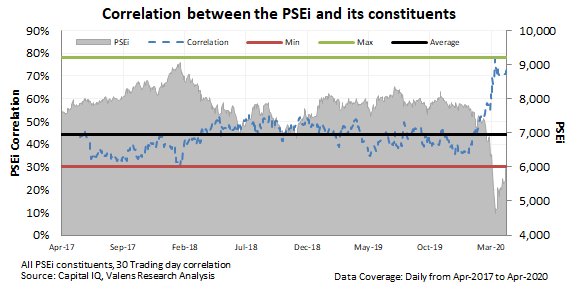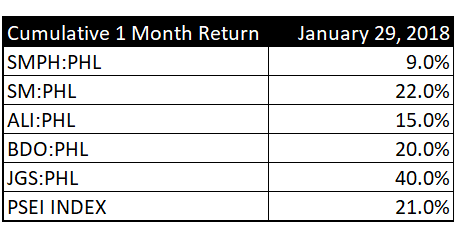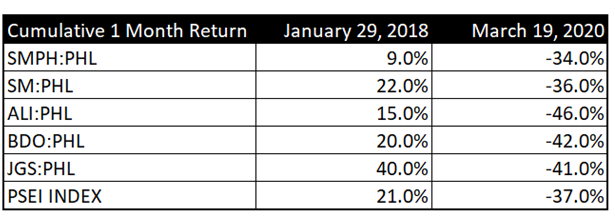MONDAY MACRO: Correlating with the Market: The Philippine Stock Market has recovered 25% from its recent low. Are we past the bottom?

Since 2017, the Philippines has been seen as one of the fastest growing emerging countries relative to its Southeast Asian peers, partly due to favorable fiscal policies, which boosted investor confidence.
Investor optimism for the economy’s outlook is also driven by factors such as stronger consumer consumption driven by young population demographics, improving ease of doing business, and an investment grade credit rating.
Despite these favorable economic conditions however, the Philippine Stock Exchange Index (PSEi) still registered a YTD low of -40% on March 19, 2020 due to COVID-19-related fears.
As of April 17, 2020, the PSEi YTD is now -26% with the majority of the recovery from the last two weeks. Does this mean investor confidence has truly returned?
Philippine Markets Daily:
The Monday Macro Report
Powered by Valens Research
In today’s Monday Macro Report, we showcase the usefulness of correlation in obtaining new insights. One interesting chart is the day-to-day correlation between the PSEi and the average movement of its constituents.
This correlation chart helps us understand investor sentiment in the Philippines. A higher correlation indicates higher perceived market risk. This means that investors pay more attention to the market as a whole and not to the risk of the individual companies.
Said simply, when investors are not concerned about the general condition of the stock market, they will focus more on the risk associated with investing in certain stocks. This usually means certain stocks will not move the same way as the index.
Historically, the daily 30-Trading day correlation moved around its average level of 40%. This trend broke in March, jumping to a 70% correlation.

Fears surrounding the COVID-19 pandemic and the uncertainty of the enhanced community quarantine (ECQ) caused panic selling in the Philippine stock market. Companies that typically do well even in periods of economic crisis saw their stock prices fall as much as the stock prices of companies that had to completely shut down during ECQ.
It did not matter what the business was — investors just wanted to be out of the stock market.
This market sell-off resulted in historically high levels of correlation between the PSEi and its constituents. This high correlation shows that investors focused on market risk, not company-specific risk.
Conversely, when correlations are low, that means investors are not concerned about overall market risk. This usually happens when the market is up. For example, when the PSEi reached an all-time high of 9,058 points on January 29, 2018, correlation reached a 3-year low of 30%.
If we were to take a look at the top 5 largest firms by market cap, we’ll see their 1-month cumulative returns vary at the time the PSEi was at its highest level. Their returns ranged between 9% and 40%, while the PSEi returns were at 21%. This shows that investors were more selective with their stock transactions.

On the other hand, the down market driven by the COVID-19 economic shock shows 1-month cumulative returns between -34% and -46%, in line with the PSEi’s -37% returns. This shows that stock price movements for these large companies mirrored the Philippine stock market index. This is indicative of a market risk sentiment rather than company-specific risk.

The correlation significantly increased over the latter half of March to over 70%. It then reached a 3-year high of 78% last March 23, 2020, before coming down to 73% as of April 17, 2020.
Though the correlation has slightly declined over the last two weeks, we can deduce that investor confidence will have returned when we’re at average correlation levels.
As the pandemic continues to be an issue in conducting business and implementing government projects, investors will likely stay cautious.
Perceived market risk versus individual company risk remains to be high but declining, implying investors are slowly regaining their appetite for risk in search for higher return. However, this will likely stay low given the country’s current abilities to counter the pandemic.
About the Philippine Market Daily
“The Monday Macro Report”
When just about anyone can post just about anything online, it gets increasingly difficult for an individual investor to sift through the plethora of information available.
Investors need a tool that will help them cut through any biased or misleading information and dive straight into reliable and useful data.
Every Monday, we publish an interesting chart on the Philippine economy and stock market. We highlight data that investors would normally look at, but through the lens of Uniform Accounting, a powerful tool that gets investors closer to understanding the economic reality of firms.
Understanding what kind of market we are in, what leading indicators we should be looking at, and what market expectations are, will make investing a less monumental task than finding a needle in a haystack.
Hope you’ve found this week’s macro chart interesting and insightful.
Stay tuned for next week’s Monday Macro report!
Regards,
Angelica Lim
Research Director
Philippine Markets Daily
Powered by Valens Research
www.valens-research.com




